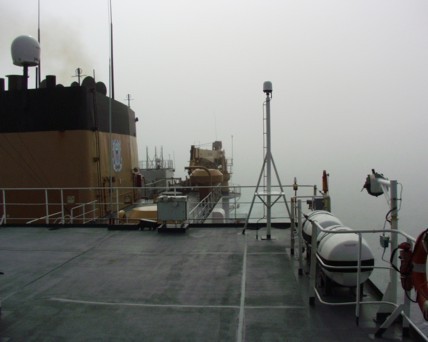|
|
Expedition
Expedition | People
|
Log - July-22-2003
by Robert McCarthy
Previous | Next
| Steaming north |
|
First the answers from yesterday's questions: The circumference of the earth based on the numbers given to you is 40,003 km. 17 nm/hr is equivalent to 19.6 miles per hour, and assuming 17nm/hr, we will have traveled 756 km in 1 full day, which is about 6.8 degrees of latitude.
|
 |
Today we were awakened to the sound of fog horns. Traveling north, we experienced warmer air over cold ocean temperatures which creates condensation of the moist air, termed fog. California is a good example, as the cold waters in San Francisco Bay interacts with the warm air above to create fog under the Golden Gate Bridge. The ship blew the fog horns every four minutes to warn potential ships of our approach. I started hearing them around 0400 hours, and this continued until the fog lifted by around 0700 hours. I never heard another distant reply, but the shipÕs radar was watched keenly. I heard there was an ice-berg sighting this morning to our west, and the predominant flow south out of the Baffin Bay is along the east coast of Canada. |
|
Today is fairly calm, although the winds and sea state have increased so the ship's motion is more easily detectable. I'm starting to establish a routine of life onboard the Healy. The research is still 2 days away so scientists are checking the equipment and trouble shooting as best they can. But the relaxed atmosphere will certainly change once we arrive on station. Daily diversions include working out in the gym, (freeweights, weight machines, treadmills, steppers, exercise cycles, and rowing machines), taking pictures with my 35 mm camera as well as a digital one for the web, logging activities for the journal, and talking to scientists about their research. Also the crew shows movies in the evenings, and they have a nice library on the ship with a diverse collection of books. |
|
Today's calculation involves the fuel capability of the Healy. Total capacity is listed at 1,220,915 gallons (4,621,000 liters). If the density of the fuel is 880 kg per meter cubed, how much water (in liters) is displaced when the tank is full? What is the mass of this water? Given that 1 meter cubed is 1000 liters, and the density of seawater is 1023 kg per meter cubed.
|
|
